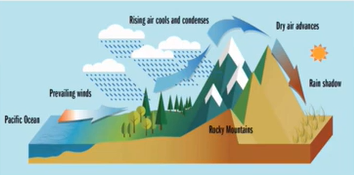Rocky Mountains 1 & 2
Rocky Mountains 1
Central United States
What defines the prairie complex in the central U.S.?
treeless; less than 10% forested
Why?
Too dry; less than 15 inches of rain
Rain shadow effect (rain drops in coastal areas because clouds don’t make it over mountains)
Rain shadow effect
Rain shadow: area of low rainfall on the leeward side of a mountain range, away from the prevailing weather system
as the clouds rise to move over the Rockies, their precipitation drops out as the air cools and condenses
Prairie: 15-20 inches of annual rainfall
Desert: less than 10 inches of rain

Rocky Mountains: Fast facts
The Rocky Mountain Complex stretches from Alberta to Mexico
States include MT, ID, ND, SD, KS, CO, UT, NM, NB, and part of TX, AZ, and WY
Mountains are taller younger drier and more rugged than the Appalachians
Formed 80-55 million years ago
In Mexico, they become the Sierra Madre
Sierra Madre Mountains
The Rocky Mountains split and become the Sierra Madre Mountains to the south, in Mexico
Sierra: rocky, ragged mountain range
Madre: mother
oriental: eastern, occidental: western
Rocky Mountains: Environmental gradients
about 30% forest cover; forest is patchy
Highest peak is Mt. Elbert, CO
But the “base” is also high—about 5000 ft
Lower average precipitation than the East
Denver: 12” annually
Salt Lake City: 14” annually
What are the key environmental factors that affect forests in the Rocky Mountains?
Elevation
Rainfall
Aspect
Topography
Fire history
Lower elevations: water
Higher elevations: other factors
Rocky Mountain Region Principles forest types (lowest to highest elevation)
Forest Zone | Description | Elevation | Annual rainfall |
Transition | Non-forest to Forest | 4000-5500 ft | <15” |
Woodland | Widely spaced trees | 5500-6000 ft | 15-18” |
Sub-montane | Ponderosa pine | 6000-7000 ft | >18” |
Montane | Varies, coniferous | 7000-9000 ft | >18” |
Sub-alpine | Spruce-fir forest | 9000-11,000 ft | >18” |
Rocky Mountain Forest Region Transition Zone
Transition zone is between areas that are too dry and just wet enough for shrubs and small trees
4000-5500 ft elevation
Less than 15” of rainfall
Shrubby hardwoods (spacing and density)
overgrazing
sometimes called “sage-brush”
Principle species
cambel oak
mountain mahogany
sagebrush
Rocky Mountain Forest Region Woodland Zone
Found between 5500-6000 ft in elevation
Short, widely spaced trees > competition for water
Annual rainfall: 15-18 inches
Commonly called Pinyon pine—Juniper Woodland
Pinyon pine: pine nuts are an important and traditional food of the Navajo
Principal species:
Pinyon pine
Rocky Mountain juniper
Rocky Mountain Forest Region Submontane Zone
Found between 6000-7000 ft in elevation
Annual rainfall: >18 inches
Originally a fire-maintained savanna with widely spaced trees; today’s forests are denser
Denfse stands prone to insects, disease, and wildlife
Commonly called Ponderosa Pine Forest
Principle species:
ponderosa pine
vanilla-scented, very thick bark that sloughs off during fire
open crowns dissipate heat
one of the most fire-resilient pines owing to the thick bark
fire resistance increases with age
3 needles per fascicle; large cones
Rocky Mountain Forests
Threats
Climate change causing changes in precipitation patterns
Recent history of fire suppression has caused fuel build-up and dense stands
Susceptible to beetle outbreaks and uncontrollable wildfires
Rocky Mountains 2
Rocky Mountain Geography
Rocky Mountains
Cascades
Sierra Nevada
Columbia Basin
Great Basin
Inland Empire
What are the key env. factors that affect forests in the Rockies?
Rainfall
elevation
aspect
topography
fire history
lower elvations—weather
higher elevations—other factors
Rocky Mountain Forest Region—Montane Zone
the Montane Zone varies more with latitude/geopgrahy than lower elevation forests
Also the most biologically diverse
WHY?
Found between 7000-9000 ft in elevation
Annual rainfall: >18 inches
Species composition more variable depending on geography. We’ll see several examples.
Forest structure ranges from open to closed canopy
Some of these forests are fire adapted
Principal species:
Douglas-fir
2 varieties recognized: var. glauca and Pacific NW
Forms closed stands in some places, also grows in mixed stands
Drier sites (south and west):
Douglas-fir
Quaking aspen
Ponderosa pine
Moister sites (north)
Douglas fir
Western hemlock
Western redcedar
Grand fir
Fire-driven sites
Lodgepole pine
rockies: serotinous cones
Western white pine
Western larch
Quaking aspen
Fire interval 100-300 years
Stand-replacing catastrophic fire
Summary
Douglas-fir is the most widespread species; lots of variation by geography
Drier sites (south and west) get quaking aspen
Moister sites (north) and geography get western hemlock and western redcedar
Fire-adapted sites have lodgepole pine, which is adapted to periodic, stand-replacing fire
Rocky Mountain Forest Region Sub-Alpine Zone
Spruce-fir forest: 9000-11000 ft > 18” rainfall
highest forest zone below treeline
rainfall much less than the East
thin, rocky soils
high winds, cool, short summers, cold winters
disturbance includes avalanches
Evergreen canopy
Little to no understory—too rocky
Stunted near treeline
Principle species:
Englemann spruce, subalpine fir
Rocky Mountain Region Alpine Zone
>11,500 feet—climatic treeline
very harsh climate
extremely thin, rocky soils
high winds, cool, short summers, cold winters, deep snowpack
Alpine plants in miniature
Not quite tundra (no permafrost)
Protected areas can host a few adaptable pine species
Sprawling form
Bristlecone pine, limber pine, whitebark pine